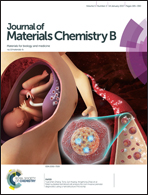Sulfonated poly(ether ether ketone) [SPEEK] nanocomposites based on hybrid nanocarbons for the detection and discrimination of some lung cancer VOC biomarkers
Abstract
The analysis of a volatolome is a promising approach to allow the early diagnosis of diseases such as cancers. However, one important challenge is to take the chemical fingerprint of the complex blend of volatiles, for many of them only present at the sub-ppm level. We have investigated a facile route to differentiate the chemo-resistive behaviour of quantum resistive vapour sensors (vQRS) and provide them with a strong methanol selectivity by simply changing the sulfonation degree of poly(ether ether ketone) up to 85%. The hybridization of carbon nanotubes (CNTs) with fullerene (C60) structured in a 3D architecture by spray layer-by-layer (sLbL) has allowed us to boost significantly the sensitivity of sensors to reach the sub-ppm level (340 ppb). After their integration into an e-nose, PEEK–nanocarbon sensors were found to effectively discriminate both single and binary mixtures of volatile organic compounds (VOCs) and among all biomarkers to detect preferentially methanol with a high signal to noise ratio (200).
![Graphical abstract: Sulfonated poly(ether ether ketone) [SPEEK] nanocomposites based on hybrid nanocarbons for the detection and discrimination of some lung cancer VOC biomarkers](/en/Image/Get?imageInfo.ImageType=GA&imageInfo.ImageIdentifier.ManuscriptID=C6TB02583H&imageInfo.ImageIdentifier.Year=2017)


 Please wait while we load your content...
Please wait while we load your content...